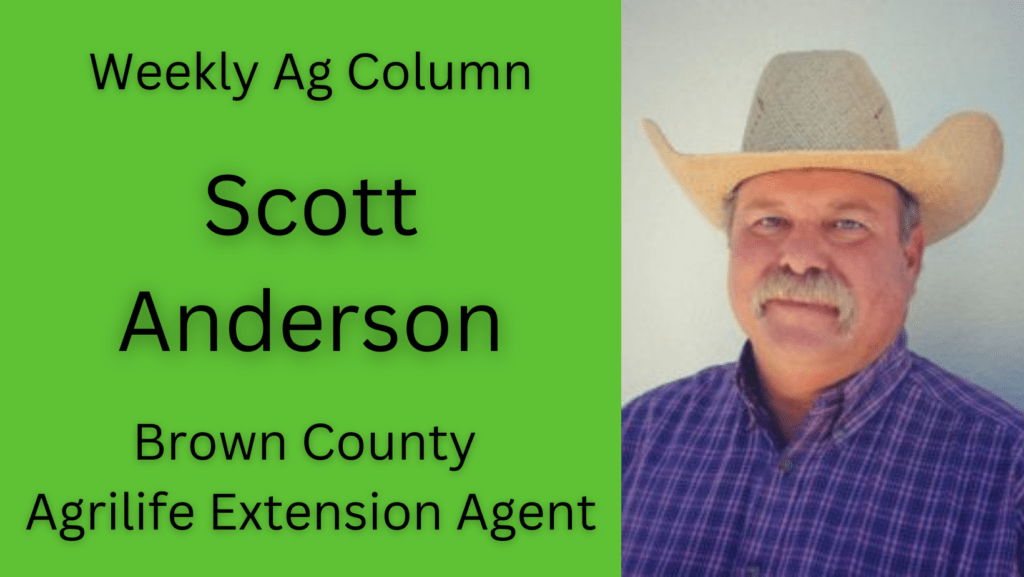
The annual Range/Pasture program held in Brownwood is set for June 18, 2024. This program is being conducted by the Texas A&M AgriLife Extension Service. It will be held at the Adams Street Community Center located at 511 East Baker Brownwood, TX. Registration will begin at 8:30am and the program at 9:00am.
The program focuses on managing range/pasture lands.
Speakers and topics for the June 18th program include:
Dr. Megan Clayton – Extension Range Specialist, Uvalde
Common Mistakes with Herbicides
Proper Herbicide Selection and Application
Greg Wilson – Extension Entomologist, San Angelo
Pesticides Modes of Action
Richard Poche, CEO Scimetrics Ltd Corp., Wellington, CO.
Kaput Feral Swine Toxicant Use
Scott Anderson – CEA-AG/NR
Pesticide Laws and Regulations
There will be a $50 registration fee payable (cash or check) for those that pre-register by June 10, 2024, otherwise it will be $60.00. A catered noon meal is included.
Pesticide applicators who are licensed with the Texas Department of Agriculture will receive 5 CEU’s
To pre-register or for more information contact the Brown County Extension Office at 325-646-0386.
***
The benefits of Texas beef
A cow here. A cow there. Cows everywhere!
That’s because Texas is the top beef-producing state in the nation, and raising cattle is the largest part of Texas agriculture.
And that means tasty, flavorful beef in all forms on your table.
The ways ranchers raise cattle in the Lone Star State are as diverse as Texas itself. Grass-fed, grain-fed, cow-calf, stocker, purebred operations—all play a unique role in providing a safe, nutritious product for niche and mainstream consumer markets.
A priority shared by all Texas cattlemen and women, however, is providing proper care to raise livestock.
Part of that responsibility is treating animals when they get sick.
Responsible antibiotic use on the farm and ranch is a safe, and needed, practice. It’s case-specific. Ranchers consult their veterinarian and work quickly to administer treatment, so a disease doesn’t spread and put all livestock at risk.
Ranchers also have training programs, like the Beef Quality Assurance program, that help them better understand animal care and handling practices.
Raising cattle with those principles leads to quality beef.
Enjoy a lip-smacking-good meal of steak or roast? How about a juicy hamburger? You can’t have the real thing without cattle.
And what about cheese, butter, a cold glass of milk? Or ice cream on a hot summer day? You need ol’ Bessie around for that.
Cattle also bring in more than $13 billion annually to the Texas economy. Now that’s a lot of moola!
But there’s more.
Cattle provide insulin and other valuable medicines. Their fats and fatty acids are used to make deodorant, lotions, cement, chalk and candles.
Plastics, lamination, wallpaper, adhesives and more are made from hooves and horns.
Cattle hair is used for air filters, brushes, insulation and felt. Bones are used for charcoal, fertilizer and glass. Their internal organs are even used to make instrument strings, tennis racket strings, vitamins and more!
Byproducts of the hide include medicines, leather, gelatin, flavorings and adhesives.
And if you’re concerned about the impact of cattle on the environment? Don’t be. Cattle only count for about 3% of greenhouse gas emissions. In fact, the staggering majority of greenhouse gases are due to transportation and electricity production.
Cattle are also the ultimate recyclers. They eat the byproducts of ethanol in your car, the cotton t-shirt you wear and even the beer in your glass. Without cattle, hundreds of thousands of pounds of byproducts would end up as waste in landfills. Instead, cattle can convert them into tasty protein.
They even upcycle land that is unsuitable for human food consumption and sequester carbon while doing so.
Eating beef, and all meat, is a choice—free of climate guilt. Bite into these five facts that show you beef is much “greener” than you’ve been led to believe.
And celebrate National Beef Month with us by enjoying your favorite beef dish.